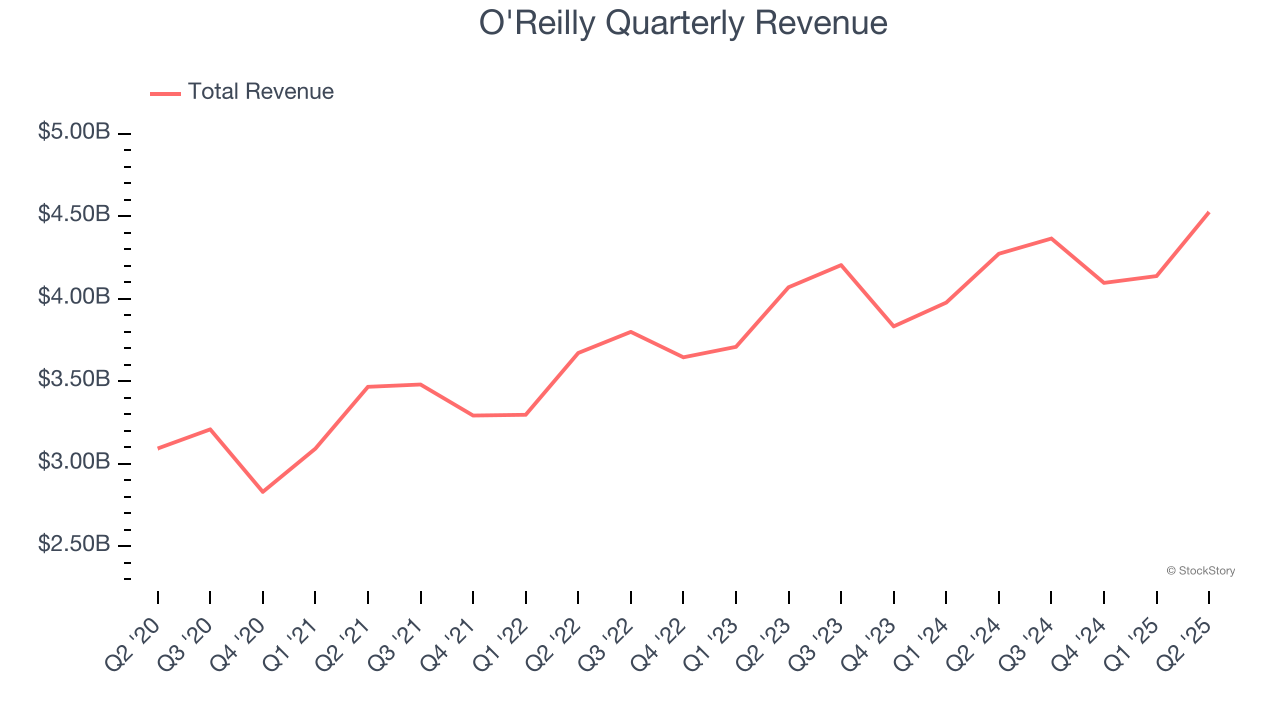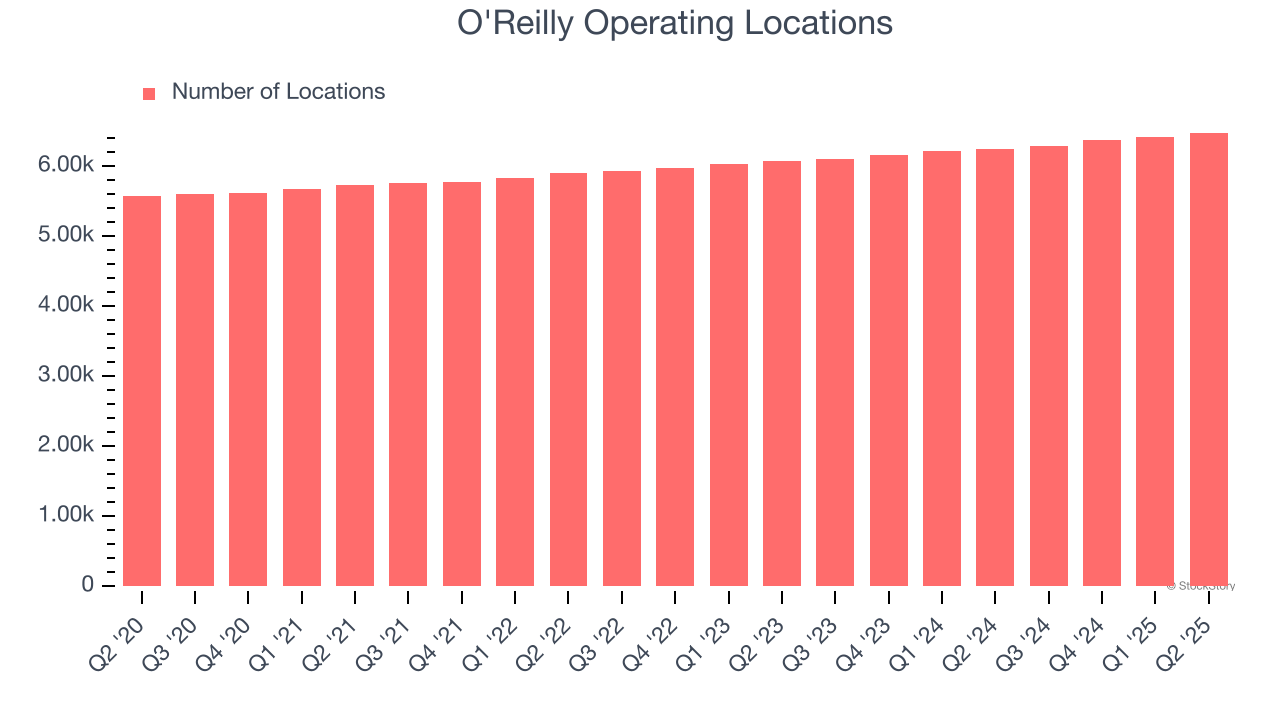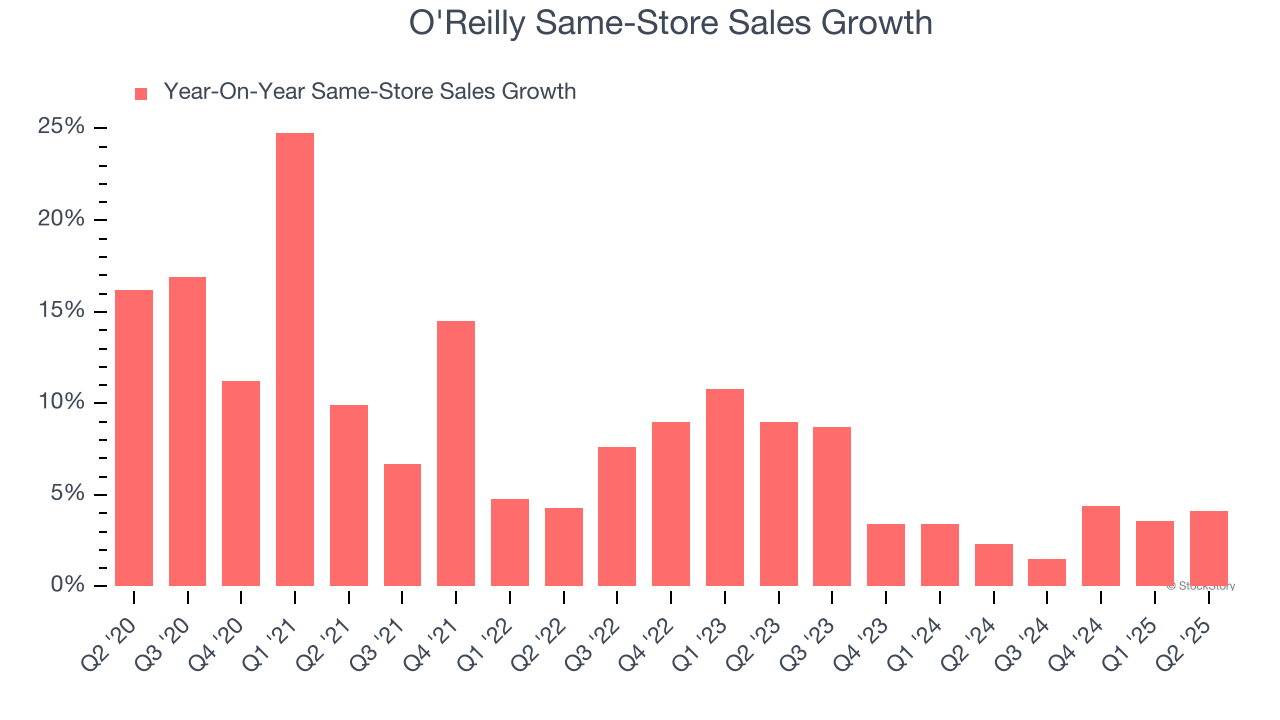
Auto parts and accessories retailer O’Reilly Automotive (NASDAQ:ORLY) met Wall Street’s revenue expectations in Q2 CY2025, with sales up 5.9% year on year to $4.53 billion. The company’s outlook for the full year was close to analysts’ estimates with revenue guided to $17.65 billion at the midpoint. Its GAAP profit of $0.78 per share was in line with analysts’ consensus estimates.
Is now the time to buy O'Reilly? Find out by accessing our full research report, it’s free.
O'Reilly (ORLY) Q2 CY2025 Highlights:
- Revenue: $4.53 billion vs analyst estimates of $4.53 billion (5.9% year-on-year growth, in line)
- EPS (GAAP): $0.78 vs analyst estimates of $0.78 (in line)
- The company slightly lifted its revenue guidance for the full year to $17.65 billion at the midpoint from $17.55 billion
- EPS (GAAP) guidance for the full year is $2.90 at the midpoint, missing analyst estimates by 1%
- Operating Margin: 20.2%, in line with the same quarter last year
- Free Cash Flow Margin: 9.9%, down from 16.8% in the same quarter last year
- Locations: 6,483 at quarter end, up from 6,244 in the same quarter last year
- Same-Store Sales rose 4.1% year on year (2.3% in the same quarter last year)
- Market Capitalization: $81.51 billion
Brad Beckham, O’Reilly’s CEO, commented, “I would like to thank our Team of over 92,000 Professional Parts People for their tremendous hard work and commitment to providing industry-leading customer service in each of our 6,483 stores. Team O’Reilly’s dedication was reflected in our strong top-line performance this quarter with a comparable store sales increase of 4.1%, driven by solid growth in both professional and DIY. Our Team’s unwavering commitment to executing on the fundamentals of our business translated our top-line results into an 11% increase in diluted earnings per share, and we remain very confident in our Team’s ability to continue to profitably grow our business and gain share in all the markets in which we operate.”
Company Overview
Serving both the DIY customer and professional mechanic, O’Reilly Automotive (NASDAQ:ORLY) is an auto parts and accessories retailer that sells everything from fuel pumps to car air fresheners to mufflers.
Revenue Growth
A company’s long-term sales performance can indicate its overall quality. Any business can put up a good quarter or two, but the best consistently grow over the long haul.
With $17.12 billion in revenue over the past 12 months, O'Reilly is one of the larger companies in the consumer retail industry and benefits from a well-known brand that influences purchasing decisions. However, its scale is a double-edged sword because it’s harder to find incremental growth when you’ve penetrated most of the market. For O'Reilly to boost its sales, it likely needs to adjust its prices or lean into foreign markets.
As you can see below, O'Reilly’s sales grew at a mediocre 9.7% compounded annual growth rate over the last six years (we compare to 2019 to normalize for COVID-19 impacts), but to its credit, it opened new stores and increased sales at existing, established locations.

This quarter, O'Reilly grew its revenue by 5.9% year on year, and its $4.53 billion of revenue was in line with Wall Street’s estimates.
Looking ahead, sell-side analysts expect revenue to grow 6.2% over the next 12 months, a deceleration versus the last six years. We still think its growth trajectory is attractive given its scale and indicates the market is forecasting success for its products.
Unless you’ve been living under a rock, it should be obvious by now that generative AI is going to have a huge impact on how large corporations do business. While Nvidia and AMD are trading close to all-time highs, we prefer a lesser-known (but still profitable) stock benefiting from the rise of AI. Click here to access our free report one of our favorites growth stories.
Store Performance
Number of Stores
A retailer’s store count influences how much it can sell and how quickly revenue can grow.
O'Reilly sported 6,483 locations in the latest quarter. Over the last two years, it has opened new stores quickly, averaging 3.2% annual growth. This was faster than the broader consumer retail sector.
When a retailer opens new stores, it usually means it’s investing for growth because demand is greater than supply, especially in areas where consumers may not have a store within reasonable driving distance.

Same-Store Sales
A company's store base only paints one part of the picture. When demand is high, it makes sense to open more. But when demand is low, it’s prudent to close some locations and use the money in other ways. Same-store sales gives us insight into this topic because it measures organic growth for a retailer's e-commerce platform and brick-and-mortar shops that have existed for at least a year.
O'Reilly’s demand has been spectacular for a retailer over the last two years. On average, the company has increased its same-store sales by an impressive 3.9% per year. This performance suggests its rollout of new stores is beneficial for shareholders. We like this backdrop because it gives O'Reilly multiple ways to win: revenue growth can come from new stores, e-commerce, or increased foot traffic and higher sales per customer at existing locations.

In the latest quarter, O'Reilly’s same-store sales rose 4.1% year on year. This performance was more or less in line with its historical levels.
Key Takeaways from O'Reilly’s Q2 Results
Revenue and EPS were both in line. With regards to positives, it was good to see O'Reilly narrowly top analysts’ gross margin expectations this quarter. On the other hand, its full-year EPS guidance slightly missed. Overall, this was a mixed quarter. The stock traded down 1.1% to $94.48 immediately following the results.
Big picture, is O'Reilly a buy here and now? When making that decision, it’s important to consider its valuation, business qualities, as well as what has happened in the latest quarter. We cover that in our actionable full research report which you can read here, it’s free.
